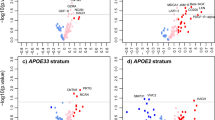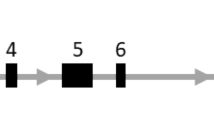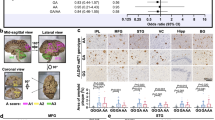Abstract
3-Hydroxy-3-methyglutaryl coenzyme A reductase (HMGCR) is a cholesterol-regulating gene with statin relevance. rs3846662 being involved in regulation of HMGCR alternative splicing, we explored its impact on HMGCR messenger RNA (mRNA) and protein levels in the brain and the associations between those levels and levels of Alzheimer’s disease pathological markers. We used brain samples derived from a cohort of 33 non-demented controls and 90 Alzheimer’s disease autopsied-confirmed cases. HMGCR mRNA levels were determined in the frontal cortex (n = 114) and cerebellum (n = 110) using Taqman-qPCR, and HMGCR protein levels were determined in the frontal cortex (n = 117) using a commercial enzyme immunoassay. While densities of neurofibrillary tangles and senile plaques were determined in the frontal cortex (n = 74), total tau, phosphorylated Tau, and beta-amyloid 1–42 levels were determined in the frontal cortex (n = 94) and cerebellum (n = 91) using commercial enzyme immunoassays. Despite an increase in full-length HMGCR mRNA ratio in the frontal cortex of women carrying the AA genotype, there were no associations between rs3846662 and HMGCR mRNA or protein levels. An increased Δ13 HMGCR mRNA ratio was associated with increased levels of HMGCR proteins and neurofibrillary tangles in the frontal cortex but with reduced beta-amyloid 1–42 levels in the cerebellum, suggesting a brain cell type- or a disease progression-dependent association.



Similar content being viewed by others
References
Adlard PA, Cummings BJ (2004) Alzheimer’s disease—a sum greater than its parts? Neurobiol Aging 25(6):725–733, discussion 743–726
Aulchenko YS, Ripatti S, Lindqvist I et al (2009) Loci influencing lipid levels and coronary heart disease risk in 16 European population cohorts. Nat Genet 41(1):47–55
Azevedo FA, Carvalho LR, Grinberg LT et al (2009) Equal numbers of neuronal and nonneuronal cells make the human brain an isometrically scaled-up primate brain. J Comp Neurol 513(5):532–541
Benjamin R, Leake A, McArthur FK et al (1994) Protective effect of apoE epsilon 2 in Alzheimer’s disease. Lancet 344(8920):473
Berson A, Barbash S, Shaltiel G et al (2013) Cholinergic-associated loss of hnRNP-A/B in Alzheimer’s disease impairs cortical splicing and cognitive function in mice. EMBO Mol Med 4(8):730–742
Biamonti G, Bassi MT, Cartegni L et al (1993) Human hnRNP protein A1 gene expression. Structural and functional characterization of the promoter. J Mol Biol 230(1):77–89
Boukakis G, Patrinou-Georgoula M, Lekarakou M, Valavanis C, Guialis A (2010) Deregulated expression of hnRNP A/B proteins in human non-small cell lung cancer: parallel assessment of protein and mRNA levels in paired tumour/non-tumour tissues. BMC Cancer 10:434
Burkhardt R, Kenny EE, Lowe JK et al (2008) Common SNPs in HMGCR in micronesians and whites associated with LDL-cholesterol levels affect alternative splicing of exon13. Arterioscler Thromb Vasc Biol 28(11):2078–2084
Chasman DI, Posada D, Subrahmanyan L, Cook NR, Stanton VP Jr, Ridker PM (2004) Pharmacogenetic study of statin therapy and cholesterol reduction. JAMA 291(23):2821–2827
Chung JY, Cho SK, Oh ES et al (2012) Effect of HMGCR variant alleles on low-density lipoprotein cholesterol-lowering response to atorvastatin in healthy Korean subjects. J Clin Pharmacol 52(3):339–346
Corder EH, Saunders AM, Strittmatter WJ et al (1993) Gene dose of apolipoprotein E type 4 allele and the risk of Alzheimer’s disease in late onset families. Science 261(5123):921–923
Corder EH, Saunders AM, Risch NJ et al (1994) Protective effect of apolipoprotein E type 2 allele for late onset Alzheimer disease. Nat Genet 7(2):180–184
Delacourte A, David JP, Sergeant N et al (1999) The biochemical pathway of neurofibrillary degeneration in aging and Alzheimer’s disease. Neurology 52(6):1158–1165
Etienne P, Robitaille Y, Wood P, Gauthier S, Nair NP, Quirion R (1986) Nucleus basalis neuronal loss, neuritic plaques and choline acetyltransferase activity in advanced Alzheimer’s disease. Neuroscience 19(4):1279–1291
Feldman HH, Doody RS, Kivipelto M et al (2010) Randomized controlled trial of atorvastatin in mild to moderate Alzheimer disease. LEADe. Neurology 74:956–964
Fleige S, Pfaffl MW (2006) RNA integrity and the effect on the real-time qRT-PCR performance. Mol Aspects Med 27(2–3):126–139
Goldstein JL, Brown MS (1990) Regulation of the mevalonate pathway. Nature 343(6257):425–430
Hiura Y, Tabara Y, Kokubo Y et al (2010) Association of the functional variant in the 3-hydroxy-3-methylglutaryl-coenzyme a reductase gene with low-density lipoprotein-cholesterol in Japanese. Circ J 74(3):518–522
Hofman A, Ott A, Breteler MM et al (1997) Atherosclerosis, apolipoprotein E, and prevalence of dementia and Alzheimer’s disease in the Rotterdam Study. Lancet 349(9046):151–154
Hubbard K, Dhanaraj SN, Sethi KA et al (1995) Alteration of DNA and RNA binding activity of human telomere binding proteins occurs during cellular senescence. Exp Cell Res 218(1):241–247
Istvan ES, Palnitkar M, Buchanan SK, Deisenhofer J (2000) Crystal structure of the catalytic portion of human HMG-CoA reductase: insights into regulation of activity and catalysis. EMBO J 19(5):819–830
Jean-Philippe J, Paz S, Caputi M (2013) hnRNP A1: the Swiss army knife of gene expression. Int J Mol Sci 14(9):18999–19024
Jick H, Zornberg GL, Jick SS, Seshadri S, Drachman DA (2000) Statins and the risk of dementia. Lancet 356(9242):1627–1631
Johnson JM, Castle J, Garrett-Engele P et al (2003) Genome-wide survey of human alternative pre-mRNA splicing with exon junction microarrays. Science 302(5653):2141–2144
Kalaria RN, Maestre GE, Arizaga R et al (2008) Alzheimer’s disease and vascular dementia in developing countries: prevalence, management, and risk factors. Lancet Neurol 7(9):812–826
Kamma H, Portman DS, Dreyfuss G (1995) Cell type-specific expression of hnRNP proteins. Exp Cell Res 221(1):187–196
Khachaturian ZS (1985) Diagnosis of Alzheimer’s disease. Arch Neurol 42(11):1097–1105
Khatoon S, Grundke-Iqbal I, Iqbal K (1992) Brain levels of microtubule-associated protein tau are elevated in Alzheimer’s disease: a radioimmuno-slot-blot assay for nanograms of the protein. J Neurochem 59(2):750–753
Krauss RM, Mangravite LM, Smith JD et al (2008) Variation in the 3-hydroxyl-3-methylglutaryl coenzyme a reductase gene is associated with racial differences in low-density lipoprotein cholesterol response to simvastatin treatment. Circulation 117(12):1537–1544
Leduc V, Domenger D, De Beaumont L, Lalonde D, Belanger-Jasmin S, Poirier J (2011a) Function and comorbidities of apolipoprotein e in Alzheimer’s disease. Int J Alzheimers Dis 2011:974361
Leduc V, Legault V, Dea D, Poirier J (2011b) Normalization of gene expression using SYBR green qPCR: a case for paraoxonase 1 and 2 in Alzheimer’s disease brains. J Neurosci Methods 200(1):14–19
Leduc V, De Beaumont L, Theroux L et al (2015a) HMGCR is a genetic modifier for risk, age of onset and MCI conversion to Alzheimer’s disease in a three cohorts study. Mol Psychiatry 20(7):867–873
Leduc V, Bourque L, Poirier J, Dufour R. (2015b) Role of rs3846662 and HMGCR alternative splicing in statin efficacy and baseline lipid levels in familial hypercholesterolemia. Pharmacogenet Genomics. doi:10.1097/FPC.0000000000000178
Li G, Larson EB, Sonnen JA et al (2007) Statin therapy is associated with reduced neuropathologic changes of Alzheimer disease. Neurology 69(9):878–885
Lu Y, Feskens EJ, Boer JM et al (2010) Exploring genetic determinants of plasma total cholesterol levels and their predictive value in a longitudinal study. Atherosclerosis 213(1):200–205
Marchant NL, Reed BR, Sanossian N et al (2013) The aging brain and cognition: contribution of vascular injury and abeta to mild cognitive dysfunction. JAMA Neurol 70(4):488–495
Medina MW, Krauss RM (2009) The role of HMGCR alternative splicing in statin efficacy. Trends Cardiovasc Med 19(5):173–177
Medina MW, Gao F, Ruan W, Rotter JI, Krauss RM (2008) Alternative splicing of 3-hydroxy-3-methylglutaryl coenzyme A reductase is associated with plasma low-density lipoprotein cholesterol response to simvastatin. Circulation 118(4):355–362
Medina MW, Gao F, Naidoo D et al (2011) Coordinately regulated alternative splicing of genes involved in cholesterol biosynthesis and uptake. PLoS One 6(4):e19420
Patry C, Bouchard L, Labrecque P et al (2003) Small interfering RNA-mediated reduction in heterogeneous nuclear ribonucleoparticule A1/A2 proteins induces apoptosis in human cancer cells but not in normal mortal cell lines. Cancer Res 63(22):7679–7688
Pino I, Pio R, Toledo G et al (2003) Altered patterns of expression of members of the heterogeneous nuclear ribonucleoprotein (hnRNP) family in lung cancer. Lung Cancer 41(2):131–143
Poirier J (2005) Apolipoprotein E, cholesterol transport and synthesis in sporadic Alzheimer’s disease. Neurobiol Aging 26(3):355–361
Poirier J, Davignon J, Bouthillier D, Kogan S, Bertrand P, Gauthier S (1993) Apolipoprotein E polymorphism and Alzheimer’s disease. Lancet 342(8873):697–699
Riekse RG, Li G, Petrie EC et al (2006) Effect of statins on Alzheimer’s disease biomarkers in cerebrospinal fluid. J Alzheimers Dis 10(4):399–406
Rockwood K, Kirkland S, Hogan DB et al (2002) Use of lipid-lowering agents, indication bias, and the risk of dementia in community-dwelling elderly people. Arch Neurol 59(2):223–227
Saunders AM, Strittmatter WJ, Schmechel D et al (1993) Association of apolipoprotein E allele epsilon 4 with late-onset familial and sporadic Alzheimer’s disease. Neurology 43(8):1467–1472
Shimada N, Rios I, Moran H, Sayers B, Hubbard K (2009) p38 MAP kinase-dependent regulation of the expression level and subcellular distribution of heterogeneous nuclear ribonucleoprotein A1 and its involvement in cellular senescence in normal human fibroblasts. RNA Biol 6(3):293–304
Simmons CR, Zou F, Younkin SG, Estus S (2011) Evaluation of the global association between cholesterol-associated polymorphisms and Alzheimer’s disease suggests a role for rs3846662 and HMGCR splicing in disease risk. Mol Neurodegener 6:62
Spies PE, Verbeek MM, Sjogren MJ, de Leeuw FE, Claassen JA (2013) Alzheimer biomarkers and clinical Alzheimer disease were not associated with increased cerebrovascular disease in a memory clinic population. Curr Alzheimer Res 11(1):40–46
Strittmatter WJ, Saunders AM, Schmechel D et al (1993) Apolipoprotein E: high-avidity binding to beta-amyloid and increased frequency of type 4 allele in late-onset familial Alzheimer disease. Proc Natl Acad Sci U S A 90(5):1977–1981
Thal DR, Rub U, Orantes M, Braak H (2002) Phases of A beta-deposition in the human brain and its relevance for the development of AD. Neurology 58(12):1791–1800
Ushigome M, Ubagai T, Fukuda H et al (2005) Up-regulation of hnRNP A1 gene in sporadic human colorectal cancers. Int J Oncol 26(3):635–640
Verdile G, Gnjec A, Miklossy J et al (2004) Protein markers for Alzheimer disease in the frontal cortex and cerebellum. Neurology 63(8):1385–1392
Wolozin B, Kellman W, Ruosseau P, Celesia GG, Siegel G (2000) Decreased prevalence of Alzheimer disease associated with 3-hydroxy-3-methyglutaryl coenzyme A reductase inhibitors. Arch Neurol 57(10):1439–1443
Wolozin B, Wang SW, Li NC, Lee A, Lee TA, Kazis LE (2007) Simvastatin is associated with a reduced incidence of dementia and Parkinson’s disease. BMC Med 5:20
Yu C, Youmans KL, LaDu MJ (2010) Proposed mechanism for lipoprotein remodelling in the brain. Biochim Biophys Acta 1801(8):819–823
Yu CY, Theusch E, Lo K et al (2014) HNRNPA1 regulates HMGCR alternative splicing and modulates cellular cholesterol metabolism. Hum Mol Genet 23(2):319–332
Acknowledgments
This study was supported by the Canadian Institute of Health Research (VL, JP), the Natural Sciences and Engineering Research Council of Canada (JP), the JL Levesque foundation (JP), the Canadian Stroke Network (VL), and the Leducq Fondation (RD).
Author information
Authors and Affiliations
Corresponding author
Ethics declarations
Conflict of Interest
The authors declare that they have no conflict of interest.
Rights and permissions
About this article
Cite this article
Leduc, V., Théroux, L., Dea, D. et al. Effects of rs3846662 Variants on HMGCR mRNA and Protein Levels and on Markers of Alzheimer’s Disease Pathology. J Mol Neurosci 58, 109–119 (2016). https://doi.org/10.1007/s12031-015-0666-7
Received:
Accepted:
Published:
Issue Date:
DOI: https://doi.org/10.1007/s12031-015-0666-7




